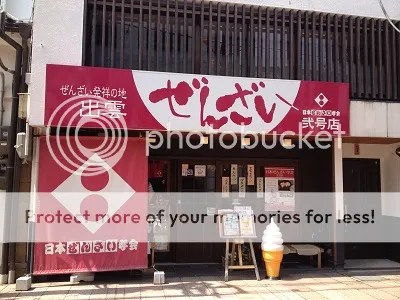サーチナの皆さまへ:私のブログを紹介してくださり、ありがとうございました。これからも頑張って山陰地域についての面白いことを英語で紹介致します。皆さまもぜひ、出雲地方に来られて出雲ぜんざいやぼてぼて茶を試してみてください!
Sweet red beans have been used throughout east Asia in a wide variety of culinary specialities, especially for desserts within Japan. Lightly crushed or smoothed to a paste, “adzuki” or “azuki” fill everything from bread buns to ice cream to pancakes to pounded rice cakes (mochi) to many, many different kinds of wagashi (traditional Japanese confectionaries). Rather than just a filling, they are also enjoyed in soup form. In the colder months, especially around New Years*, Japanese people throughout history have enjoyed the soft beans floating in a sweet warm broth or poured over a large, soft piece of mochi, or served cold in summer as a precursor to something like a refreshing and thick ice cream, but there is some confusion across the country as to what exactly this is. Is it oshiruko? Is it kameyama? Or is it zenzai?
This is much like the great pop/coke/soda debate in the US (for the record, it’s soda). Likewise, let’s set the record straight on zenzai.
A soup of mixed texture–bean paste as well as partially crushed small red beans–resulting in a jam-like consistancy, with at least a couple balls of soft mochi within. This is Izumo Zenzai.
Since it is typically written phonetically as ぜんざい, there is even some disagreement over the term “zenzai”–is it of Buddist origins(善哉), or Shinto origins? Out here in the Province of the Gods, the story has been recorded thus since at least the start of the Edo period in works of literature like “Gion Monogatari” and “Baison Saihitsu”.
As mentioned in previous posts and stories, all the gods in Japan come together at Izumo Taisha during the tenth month of the old calendar. While this is called “Kannazuki” (神無月、the month with no gods) in the rest of Japan, it is called “Kamiarizuki” (神在月、the month with gods) in the Izumo region. Having a bunch of gods among you is worth celebrating, and they did so with this dish: gods-are-here-rice-cakes, 神在餅. An alternate pronunciation of these kanji is “jin-zai,” thereby making this “jinzai-mochi”. However, Izumo dialect is known for having a bit of a slur and a drawl–or rather, like many other dialects in Japan, has completely different ways of pronouncing the same words. Therefore this was not pronounced “jinzai” as in standard Japanese, but “zenzai”.
Since the meeting the gods are having is all about en-musubi (binding fates for all humans with all nature, or more popularly understood as romantic matchmaking), zenzai also takes on a bit of an en-musubi meaning and is yet another way to indulge in en-musubi around the Izumo region.

En-Musubi style zenzai is typically served with a white ball of mochi and a pink ball of mochi. White and red (or pink) are colors typically associated with en-musubi.

Pretty easy to see where Kyomise is.
It’s a well known dessert (or any-time-of-day snack) out here, especially at the Izumo Zenzai chain across the Shimane Peninsula. They have music about zenzai, they have an official zenzai day (October 31), and they even host academic courses about zenzai. I’m pretty willing to say they’re the authorities on this dish if anyone is. This is the location in the Kyomise shopping district south of Matsue Castle.


They don’t just serve zenzai here; but a number of other desserts. Notice the door handles? If you slide the door all the way open, they make a heart that says “en-musubi.”

Zenzai can be prepared in different ways depending on the weather and on your tastes. I love matcha with almost anything, so I opted for zenzai in matcha served cold.

It comes with some pickled sides to refresh your taste buds so you don’t get overwhelmed with the sweetness.
It’s a nice little place to rest a spell, or buy some en-musubi souveniers, including instant zenzai or chopsticks. Yes, rabbits are a big thing here. I’ll be explaining that in the next Kojiki mythology manga installment.

Of course, there are also disagreements between different regions of Japan on just what “zenzai” is. Was it originally sweet, or salty? Is it beans in broth? Is it beans over mochi with no broth? Is it beans over shaved ice?? At least there is some national distinction on what Izumo Zenzai is if it even has its own sandwich modeled after it.
*Zoni, a traditional New Years dish, varies according to the region in Japan. In Tottori and Shimane prefectures, it is typically made with lots of small red beans–very zenzai-like.

June 20, 2013 at 8:49 pm
Ooh, I like this entry :D
It makes me want to eat zenzai XD I like mochi and I like azuki and I also like maccha!! Though I will need to keep an eye on the ingredients because of my eczema ^^;
Also, lol@神在月 XD I didn’t know that!
June 21, 2013 at 11:31 am
神在月 is a big enough thing around here in the Province of the Gods that it’s hardly surprising when any piece of local culture is based on it!
I can’t say I know for sure what’s in it, but I’ll bet its better fresh rather than packaged.